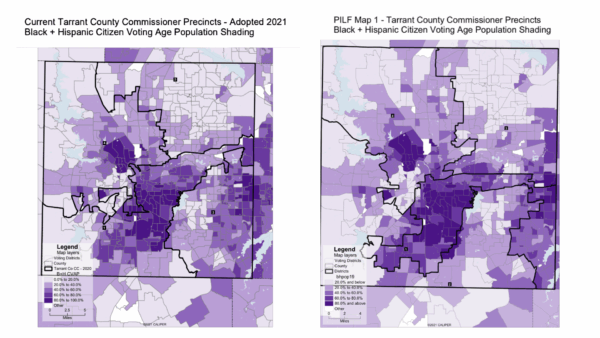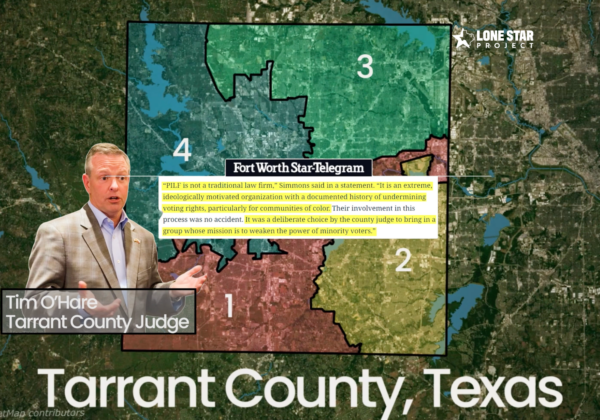Complying with the schedule ordered by District Court, parties in the Texas redistricting case filed briefs today in reply to the proposals submitted to the Court earlier this month suggesting remedies to correct the Voting Rights violations in the current illegal congressional map. Also, earlier today, the Court granted motions to intervene in the case by Congressmen Lamar Smith, Henry Bonilla and Henry Cuellar. A hearing on the case will be held in Austin on Thursday, August 3, 2006.
A summary of the reply brief filed by the Jackson Plaintiffs, who include several Texas Democratic Members of Congress, is provided below.
The entire brief can be viewed here
Perry/Craddick/Dewhurst Plan (1418C) is partisan and disruptive
Republican Attorney General Greg Abbott, on behalf of the State Republican leadership, forfeited the opportunity to represent all Texans by submitting a proposed redistricting plan that is even more disruptive than and just as partisan as Tom DeLay’s 2003 plan. The Perry brief essentially says the Court should place higher priority on partisan interests than restoring the Voting Rights of Hispanic voters.
- “… on closer inspection, the Perry Plan is an object lesson in how not to draw a remedial map. Driven more by a desire to protect the region’s two Republican incumbents than to protect the federally guaranteed voting rights of Hispanic citizens in South and West Texas, the Perry Plan gratuitously shifts well over half of the four districts’ constituents (more than 1.4 million Texans) into new districts …” (Jackson Plaintiffs’ Remedial Response Brief, July 21, 2006, page 1-2)
- “To put that figure into perspective, the 2003 Plan, which redrew the entire state and engineered an immediate six-seat Republican pickup, moved less than 40 percent of all Texans into new districts…So the Perry plan would actually move more voters per district than did the 2003 Plan.” (Jackson Plaintiffs’ Remedial Response Brief, July 21, 2006, page 17)
- Quoting from Justice Kennedy, “if…incumbency protection means excluding some voters from the district simply because they are likely to vote against the officeholder, the change is to benefit the office holder, not the voters. By purposely redrawing lines around those who oppose Bonilla, the state legislature took the latter course.” Follow on from Jackson reply brief, “By submitting the Perry Plan, Defendants are attempting to lead the Court down the same crooked path.” (Jackson Plaintiffs’ Remedial Response Brief, July 21, 2006, page 18)
Jackson Plaintiff Plan (1406C) is narrowly tailored and maintains partisan balance
The proposal submitted by the Jackson plaintiffs and Democratic congressional interveners is narrowly tailored and maintains partisan balance consistent with the legal mandate of the Supreme Court decision. The Jackson plan fully restores Voting Rights to Hispanic voters, respects community and regional interests, and provides incumbents of both parties a legitimate opportunity to seek and win reelection.
- “Fortunately, the Court can avoid all these problems simply by adopting the Jackson Plan (Plan 1406C) and putting it into effect for the upcoming November 2006 elections. The Jackson Plan fully cures the defects in Districts 23 and 25, complies with all federal legal requirements, adheres to the State’s traditional neutral districting principles, and otherwise does what any court-ordered map should do: leave well enough alone.” (Jackson Plaintiffs’ Remedial Response Brief, July 21, 2006, page 2)
Perry/Craddick/Dewhurst Plan fails to remedy Voting Rights violations
The GOP plan does not restore the Hispanic voting age population of District 23 to the level that barely made it effective for Hispanic voters before it was drawn illegally in 2003. Likewise, the GOP plan fails to correct the objectionable “bacon strip” District 25, which would still stretch hundreds of miles from the Rio Grande to the outskirts of Austin.
- The Perry Plan would leave 40,000 of those illegally injured Hispanics in a district that Defendants admit is designed to elect Congressman Bonilla rather than a Hispanic-preferred candidate. (Jackson Plaintiffs’ Remedial Response Brief, July 21, 2006, page 10)
- The Perry Plan’s District 25 continues to run nearly 300 miles north from the Rio Grande Valley (in Hidalgo County) all the way to the edge of Travis County, in the heart of Central Texas. Indeed, the Perry Plan’s District 25 is only 20 miles shorter than the 2003 Plan’s District 25.” (Jackson Plaintiffs’ Remedial Response Brief, July 21, 2006, page 14)
- “To assume that Hispanics in the Austin area and Hispanics in the McAllen area ‘belong’ in the same district is to engage in rank stereotyping.” (Jackson Plaintiffs’ Remedial Response Brief, July 21, 2006, page 15)
Perry/Craddick/Dewhurst Plan is calculated to punish Democratic neighborhoods
The proposed GOP plan is excessively disruptive and calculated to punish voters who dare to prefer Democrats. The GOP plan would move 54% of the residents of the four districts affected into new districts. Every resident of Travis County (531,000, or 65%) affected by the GOP plan would be moved into a new district, and the Hispanic South Side San Antonio community would literally be split in half by this “fruit basket turns over” plan.
- “The Perry Plan splits the South Side of San Antonio and Bexar County, moving almost 128,000 residents, including 67,280 Hispanics and 29,750 African Americans, out of District 28 and into District 25, which is anchored in the Rio Grande Valley.” (Jackson Plaintiffs’ Remedial Response Brief, July 21, 2006, page 26)
- The Perry Plan separates the entire South Austin Hispanic community west of Interstate 35 from the Hispanic neighborhoods of East and Southeast Austin and places it in District 23. (Jackson Plaintiffs’ Remedial Response Brief, July 21, 2006, page 27)
- The Bexar and Travis County neighborhoods discussed here are just a few of those that would be adversely affected under the Perry Plan. It would be cruel irony if a federal court tasked with the duty of remedying a Voting Rights Act violation ended up sundering these minorities communities and thereby silencing their already weak voice in Texas and national politics. (Jackson Plaintiffs’ Remedial Response Brief, July 21, 2006, page 27)
Perry/Craddick/Dewhurst Plan deliberately pairs incumbents and misleads the Court
One element of the Perry/GOP map particularly signals the cynicism and arrogance of its sponsors – their clumsy attempt to mislead the Court and the public about the pairing of incumbents. The Perry brief falsely claims that Doggett currently lives in a Republican held seat which is simply wrong. In fact, he lives in the District he represents, CD25.
- “Thus, it appears that Defendants have knowingly replicated one of the most devious features of the 2003 Plan – pairing an Anglo Democratic incumbent with an Anglo Republican in an overwhelmingly Republican district .. Whatever one might think of such partisan manipulations when undertaken by a state legislature, they surely are ‘inappropriate for the federal court drawing a congressional redistricting map’ Balderas v. Texas, Civ. Action No. 6:01CV158, slip op. at 10.” (Jackson Plaintiffs’ Remedial Response Brief, July 21, 2006, page 20)
- “Defendants have paired Congressman Smith and Congressman Doggett, while telling the Court the opposite.” (Jac kson Plaintiffs’ Remedial Response Brief, July 21, 2006, page 29)
- “Perhaps Defendants’ partisan agenda shows through most clearly in their approach to ‘pairing.’ Their brief asserts repeatedly that the Perry Plan pairs no two incumbents in the same district See Fefs. Br. at 2, 10, 12-13. That is not true…under the Perry Plan, he (Doggett) would reside in District 21, where he would be paired with Congressman Smith” (Jackson Plaintiffs’ Remedial Response Brief, July 21, 2006, page 20)



